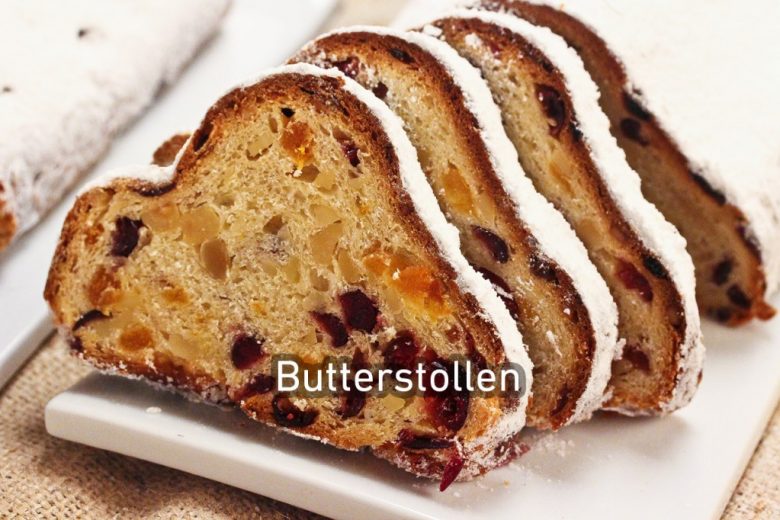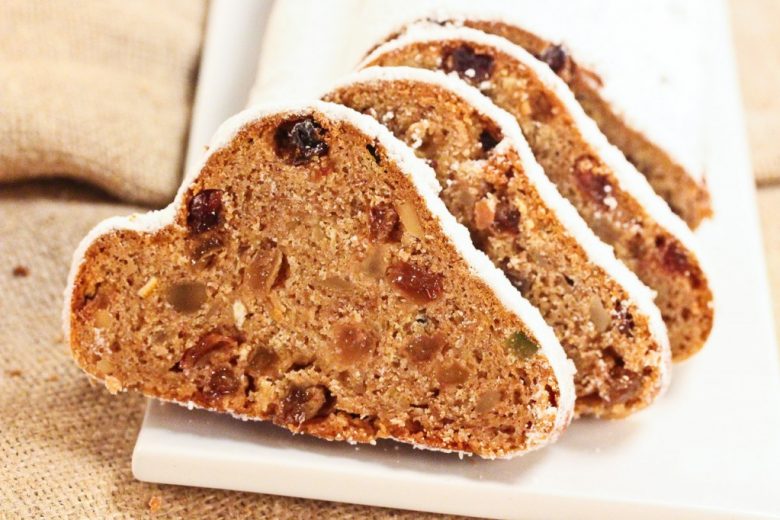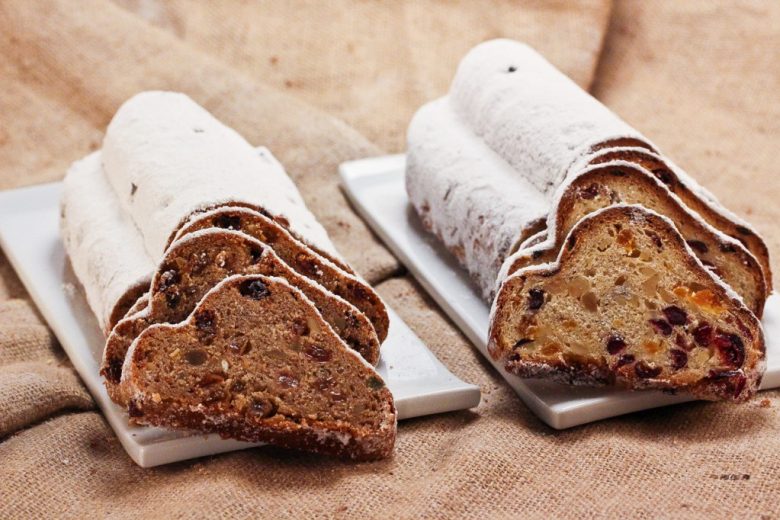Christstollen
Who baked the first stollen is still unknown, but researchers agree that the first stollen were pulled out of the oven in Saxony around 1300. It could also be that maybe monks baked the first Christmas Stollen in monasteries. They understood the art of baking and knew how to combine spices with fine ingredients.
The name of the first stollen appears in documents in 1329 in Naumburg an der Saale. At that time, the stollen did not have the familiar name. Different names were and are used for this traditional pastry. Depending on the region, these pastries are called Stollen, Striezel, Christbrot or Weihnachtsbrot.
1. Stollen Ingredients:
Wheat Flour
The production of Stollen should be made with Wheat Flour Type 700 (German 550). This type of flour develops better gluten than light flour types (Ö-480 / D-405) and thus better dough stability. Therefore, strong flour with a protein content of 12-13% and a moist gluten of 28-32 should be used for the production of stollen.
As a general rule, stronger flours absorb more water and this means the bake is more moist and will have better shelf-life.
Sugar
Sugar certainly influences the quality of the Stollen. The effects can be seen in the browning, volume, and leavening! In some Stollen recipes, the sugar is replaced with honey (spelt Stollen).
Butter
The guidelines for enriched butter Stollen stipulate at least 40% butter to 100% grain products. Only pure butter should be brushed on after baking.
Yeast
The yeast amount should be around 5-8% in the production of Stollen. Yeast contents above 10% lead to a yeasty aftertaste.
Almonds
Almond stollen can mold very quickly if handled improperly. This happens if the almonds lie in hot water for too long. As a result, the almonds absorb too much water, reducing the shelf life of the stollen to 2-3 weeks.
To achieve a longer shelf life, the almonds should be soaked in hot (60 ° C) water for 10 minutes max. Drain the remaining water, mix with the raisins, lemon peel, orange peel and rum and leave to stand covered.
Raisins/ Sultanas/ Currants
Raisins:
They come mainly from California, but also Spain and Cyprus. They are seed-like, large berries and sometimes with a stem portion.
Sultanas:
They are seedless, large berries, sweet and very flavorful. The main producers are Turkey, California, Australia and Greece.
Currants:
Seedless, small berries, purple-black color and a bit sweet and sour in taste. They were named after the Greek port of Corinth.
Candied Fruit
Citronat:
Citronat, also known as succade, is made by candying the unripe, green cedra fruit. This particular type of lemon is also called citron lemon and weighs more than 3kg.
Orangeat:
Orange peel, also called aranzini, is made by candying the peel of bitter oranges.
Stollen Spices:
Many can find Stollen Spice pre-mixed in the store, but here are a couple examples for Stollen spices:
Stollen Spice Recipe 1:
- 50g Nutmeg, ground
- 25g Cardamon
- 165g Vanilla sugar
- 500g Lemon sugar
64g of Stollen spices are added to 4kg of dough.
Stollen spice recipe 2:
- 50g Vanilla sugar
- 10g Nutmeg, ground
- 35g Cardamon
- 10g Pepper
2. Stollen Production
Pre-dough:
Just as with all sweet doughs with a high fat content, Stollen are made with an indirect dough process. A guideline for the pre-dough amount is that it should include about 50% of the total flour.
The pre-dough should not be too firm, so it is mixed to a hydration of 160. The temperature of the pre-dough should be around 24-26°C. Normally the pre-dough is used to build flavor, but in this case its only purpose is to activate the yeast’s leavening power.
Pre-mix Ingredients:
Since hardly any bulk water is added to the Stollen dough, the control of the dough temperature is mainly possible through the ingredients themselves. A safe and consistent method is to pre-mix the ingredients. It ensures an even and gentle distribution of the ingredients in the main dough, without increasing the temperature of the dough through long kneading times.
Dried Fruit:
This group of ingredients is often calculated on 100% of the flour mixture. In order to keep the crumb juicy and to keep it fresh, it is important to soak the fruit sufficiently with water beforehand. In the fully baked stollen, the crumb and fruit balance each other evenly in terms of their water content.
The washed and drained fruits are soaked in 40% rum overnight. The fruit mixture should be kept covered.
Production of the yeast pre-dough:
30-50% of the total flour, along with the yeast, sugar, and the entire bulk liquid are mixed to a target temperature of 24-25 ° C. This should always be well kneaded when making Stollen. By kneading the pre-dough, the later dough structure in the main dough is stabilized.
If the pre-dough is not kneaded, a sufficiently developed gluten structure cannot stabilize the main dough, as the high fat content envelops the proteins. With Stollen, this becomes noticeable after baking – it collapses on itself. This mistake is most noticeable on free-shaped versions!
The leavening power is also strengthened by the low-sugar pre-dough. The optimal ripening time of this portion is about 30-60 minutes at room temperature.
Production of the Butter/Fat portion:
In order to ensure that the remaining ingredients are kneaded quickly and briefly into the pre-dough, the remaining ingredients should be mixed and blended in the kneading bowl. Butter, sugar, salt and spices are mixed slowly until a homogeneous butter dough is formed.
This pretreatment makes the butter soft and pliable, and without any increase in temperature. The special thing about this pretreatment is that you can mix this butter dough into the pre-dough without kneading for long!
In mixing mechanically the main dough is often over kneaded, resulting in an oily dough. This would result in Stollen with a dense and dry crumb.
Production of the Stollen dough:
Mix the flour and butter mixture for 3-4 minutes on a slow speed. Then the ripe pre-dough is mixed in and mixed for another 4-5 minutes. The dough can now run at high speed, but only until a dough temperature of 25 ° C is reached.
After the dough has rested for 20-30 minutes, the fruit mixture can be carefully kneaded in.
Baking Stollen dough:
The best oven temperature for Stollen is between 190-200°C. The baking time depends on the recipe and the size. For 500g sized Stollen, the bake time is 50 minutes. In general, the crust should be well baked. Thick crusted Stollen have a dry crumb and tend to crumble when cut.
Inner Temperatures for Butter Stollen:
- Underbaked / 90-91°C
- normal bake / 92-93°C
- Well baked / 94-96°C
Buttering the Stollen:
Buttering the Stollen after baking is crucial for preserving the freshness. It is important that the sealing is done all over the Stollen. The inner temperature of the Stollen should still be around 40-50°C when buttering, as this ensures good penetration into the crumb.
Don’t use margarine for the buttering since it has a water content of 18% and this will reduce the shelf life of the Stollen. One reason for buttering the Stollen after the sugar is applied is that the Stollen has already cooled. In this case the Stollen doesn’t absorb the fat and it remains as a layer between the crust and the sugar coating. Under slight pressure (e.g. handling) it becomes greasy.
Sugaring of Stollen:
Evenly coat the greased stollen with granulated sugar. To ensure a good seal, the stollen should also be sprinkled with granulated sugar on the underside.
The sugaring of the stollen should not take place immediately after greasing, but only after 30 minutes. The sugar gives the Stollen its attractive appearance and complements the other flavors.
Stollen Mistakes
1. The volume is small:
- Dough was too firm
- Insufficient dough development
- Dough was too cold
- Bulk rise was too short
2. Stollen has collapses:
- Dough was too weak
- Stollen was insufficiently baked
3. The crust is ripped:
- Dough was too warm
- Dough was too old
- Dough was too firm
- Too short of dough ripening before forming
4. The pores of the Stollen are too large:
- Dough was too warm
- Dough was too old
- Dough was too firm
- Used too much yeast
5. The pores of the Stollen are too tight:
- Dough was too firm
- Dough was too cold
- Bulk rise was too short
- Dough ripening was too short
6. Stollen have settling strips:
- Dough was too weak
- Wasn’t baked long enough
7. The crumb of the Stollen is discolored:
- The fruit used wasn’t clean
- The dough was kneaded too long with the fruit
- Stollen were baked too long
8. The crumb of the Stollen is too dry:
- The dried fruits or almonds were used too dry
Recipe will come in the Advent Season!











